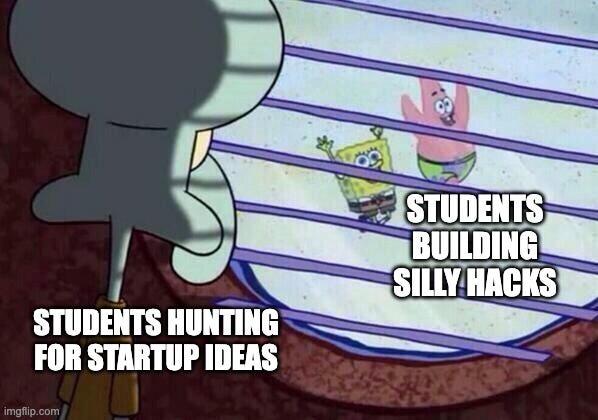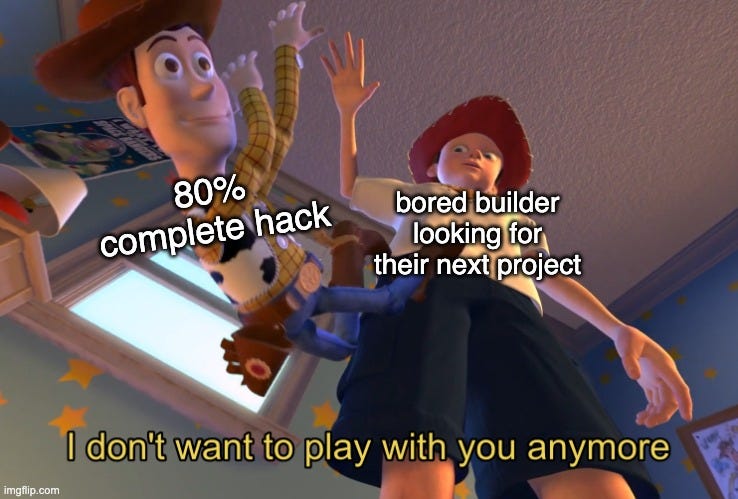Please Build More Silly Things
Hacking on fun things with curious co-conspirators is a superpower
Lightbulb ideas from young people tend to fall into one of three categories: hacks, projects, and startups. Ideas can start in a bucket, and end up in another as time passes. Let’s walk through them in reverse order. I should also note, that when I refer to “build” I generally mean making something with code/engineering, but I think a lot of the thoughts here can extrapolate to other definitions.
Startups are thesis-driven ideas. Some form of the future necessitates your idea, and you are convinced that you are the perfect person to lead the way. You can actively look for these ideas by immersing yourself among bright people, or it can fall into your lap, often after years of tossing and turning between less fruitful ones.
Projects are ideas with a means to an end. Generally, they’re not very unique, but are great tools for learning. Projects look fantastic on a resume due to their technical challenge, but can be uninspiring. You can develop real world skills by working on projects.
Finally, my favorite: hacks. Hacks can be weird (like *really* weird), random, clunky, and unpolished. But most of all, they are explorative. You learn how to harness new technologies and craft joy when hacking. It’s hard to describe hacks precisely, but everyone has a good intuition for its ingredients. Hacking is play. Hacking is for fun and curiosity.

Chris Dixon wrote about how hacks like Bitcoin, NoSQL databases, and many others found their way into the minds of playful technologists before breaking into the mainstream.
Today, the tech hobbies with momentum include: math-based currencies like Bitcoin, new software development tools like NoSQL databases, the internet of things, 3D printing, touch-free human/computer interfaces, and “artisanal” hardware like the kind you find on Kickstarter.
It’s a good bet these present-day hobbies will seed future industries. What the smartest people do on the weekends is what everyone else will do during the week in ten years.
From Chris Dixon (in 2013)
It’s important to make the distinction between startups, projects, and hacks because I often see a blurring of the buckets at school. Nearly everything students build either fall in the category of project or hack, and very rarely startup. But the skills and intuitions gathered from projects and hacks, respectively, can provide way for great startup ideas.
From my (very) limited perspective on the world, I believe that in order to open the most exclusive doors and access the most elusive opportunities, you need to be hacking.
Learn the Constraints, Win the Game
By spending time hacking (i.e. playing around for the sake of playing around), you learn what is possible and what isn’t possible. The constraints of a new technology become highly apparent. You can develop an understanding of what people will be able to do in the next [3 months/1 year/5 years] only if you can understand what people can do now.
From an instructive perspective, hacks require you to be brutally honest to yourself about what you know and what you don’t know. They also build taste. You learn what you like spending time on and what you hate with little downside.
Hacks are also high convexity. That is, the loss is always bounded (often just time) but the potential gains are uncapped. Even if you drain a lot of time into a hack, you will still learn a ton.
Some of the most impressive startups started off as hacks. Here’s an example.
Evan Wallace, an undergrad at Brown, was curious about WebGL, a new powerful graphics framework for the browser, and built a sphere in a pool of water. At the time, this doesn’t seem exciting at all, but this was the spark that lit the path that Evan and his soon-to-become cofounder Dylan Field found themselves on before building the recently acquired Figma. Something as simple and playful as “WebGL Water” gave Evan and Dylan the intuition that complex graphics in the browser were not far from reality.
It’s not just startups. Many technological fields were birthed by hacks.
For no other reason than fun, Claude Shannon and Ed Thorp wanted to build a hack that could help them win at roulette. It ended up becoming the first wearable electronic device.

Lincoln, who had a keen interest in technology and remains the only American president with a patent, spent more of his presidency in the War Department’s telegraph office than anywhere else outside of the White House…
[…]
Lincoln sent barely more than one telegram a month in the first year of his presidency, but that changed as he grew increasingly frustrated with the war’s plodding progress. He wielded the nascent technology to take greater control of the war effort after sending a flurry of telegrams on May 24, 1862, that directed his generals to move at once against the forces of Confederate General Thomas “Stonewall” Jackson.
From How Abraham Lincoln Used the Telegraph to Help Win the Civil War
Lincoln might have been one of only a few “hacker” presidents. His curious mindset about a new technology fundamentally altered communication during the Civil War. He had to first play with the telegraph before he could use it effectively.
Hacks have produced new industries, massive companies, and victories in war.
Curiosity and Co-conspirators
So, how do you get started with hacking? Well, you first need outlandish, creative ideas that can be built with existing technology.
To come with ideas, you need to initially work on projects. Learn a few things from people who do it well and within no time, you will be wondering “hmmm, what if I tried this” or “aha! this could be interesting.”
The importance here is to follow one’s own nose rather than externally provided structure. Structure is limiting. It’s very unlikely that school or classes alone will get you to build. You need to run experiments driven by curiosity in order to truly understand something in depth.
Once you have some base-level skills, you need to find likeminded peers.
You can’t grok the future from the outside. You have to be a part of the in-group. You need to be building and playing with others who are equally curious about what the future holds. This involves taking risks and messing with technology for no other reason than a desire to push it to its limit.
There’s a captivating flywheel effect here. As you hack more, more hackers will find you and you will generate more ideas. You want to get to the point where you have more ideas than time to build.
It’s hard to believe that someone who isn’t a conscious hacker will ever have a successful endeavor in a creative field. There needs to be a graveyard of past hacks. There seems to be a period of a “drunk man’s walk” moving between hacks and ideas before an ultimate breakthrough. You need a little bit of gradient descent to get to the minima — you can’t just cross your fingers and teleport there.

Hacks demonstrate your ability to tinker, contribute to the broader exploration of a new technology, and maintain a pulse on forthcoming trends.
Hacking is like getting a Willy Wonka golden ticket, granting access to a community of individuals who are shaping the future. Investigating with small, unconventional projects can demonstrate your curiosity and willingness to understand how technology can be integrated into society. As history suggests, the future will be built on top of today’s silly hacks.







love this Varun!
This article is pure gold.